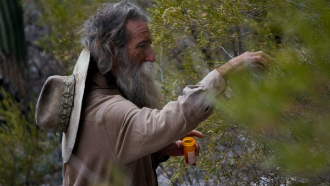
A Shape of Things to Come 2020
Distributed by Grasshopper Film, 12 East 32nd St., 4th Floor, New York, NY 10016
Produced by J.P. Sniadecki
Directed by Lisa Malloy and J.P. Sniadecki
Streaming, 77 mins
College - General Adult
Environmentalism; West (U.S.); Sociology
Date Entered: 12/15/2020
Reviewed by Susannah Benedetti, Associate Director Library Technical Services & Collection Management, University of North Carolina WilmingtonLisa Malloy and J.P. Sniadecki’s A Shape of Things to Come is an entrancing study of Sundog, an aging loner who makes a solitary living in the harsh splendor of the Sonoran Desert. The film observes his routines by day and night as he exults in spiritual harmony with the natural environment. Man and desert coexist, but both are under threat from the Border Patrol and encroaching development. Can western individualism survive against the inexorable push of 21st century urbanization? The film sets up one man’s resolution, as he perceives less danger from unforgiving terrain and rattlesnakes than from bulldozers and ATVs on the horizon.
The film is a paean to the majesty of the desert and its wildlife. Purely observational without musical score or narrative, it follows Sundog in his element through striking photography and sound production that is almost hypnotic, as hearing only wind on leaves and grasses and distant bird calls immerses us in the hushed world of the desert ecosystem. Discordant incursions of jet plane engines and the buzzing of nearby electrical towers shatter Sundog’s reverence with ominous overtones. These juxtapositions call to mind the power of Koyaanisqatsi (1982) with its presentation of humans’ sprawling modernity degrading connection to the planet, resulting in ‘life out of balance,’ as the Hopi title translates.
In this environment Sundog hunts and dresses javelina, forages poppies for a tincture, and in one remarkable sequence catches Sonoran Desert toads and extracts their hallucinogenic venom with an expert hand, drying and smoking it before sinking into the tall grass to experience the psychedelic effects. Documenting these activities alone makes for a singular glimpse of a way of life fast vanishing.
One of the film’s greatest strengths comes from the questions its minimalist sounds and imagery provoke – how isolated can one man remain in today’s hyperconnected world? Can even the Sonoran Desert itself still be considered remote? Sundog’s cell phone and pickup truck connect him to civilization as acknowledgements that no man is an island. The fact that his human interactions primarily involve Native Americans serves to layer the current tensions within the history of the indigenous peoples of the American Southwest and the manmade destruction of cultures that were built upon the ethos of man’s spiritual balance with nature.
Malloy and Sniadecki observe Sundog’s actions and capture his words as these tensions weigh upon him. He snaps the locks of a fenced compound of electrical towers, he target shoots in the grassland. He laments the rush of development that violates the desert that he views as sacred and hopes to "slow that down, fumble it up, stop it in its tracks.” What comes next is left to the viewer to imagine, but the film’s title, taken from H.G. Wells’s 1933 book foreseeing mankind in the year 2106, gives a portent.
A Shape of Things to Come would be well-suited for courses in environmental studies, sociology, West (U.S.) history, public policy, and other disciplines. The film presents breathtaking imagery and raises questions about individualism, progress and technology, the sanctity of public lands, and whether a human, a corporation, or a government can claim to ‘own’ a piece of nature.
Awards:
Nomination, DOX Award, Copenhagen International Documentary Film Festival
Published and licensed under the Creative Commons Attribution 4.0 license. Anyone can use these reviews, so long as they comply with the terms of the license.